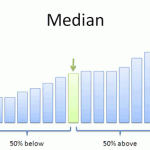Statistics Definitions > Resistance and Resistant Measures
What is Resistance?
Resistant statistics don’t change (or change a tiny amount) when outliers are added to the mix. Resistance doesn’t mean it doesn’t move at all (that would be “immovable” instead). It means there might be a little movement in your results, but not much.
When a statistic changes because of a “rogue” data point, your result can be far from the true value you’re trying to estimate. This bias can be avoided if you eliminate outliers or use weighting factorsto minimize the damage they cause.
Resistant statistics:

On the other hand, some statistics are heavily influenced by outliers. Those statistics are:
Resistance vs. Robustness
According to some authors (e.g. David C. LeBlanc in Statistics: Concepts and Applications for science, volume 2), resistant and robust mean the same thing. Other authors (e.g. Wilks) state that sometimes robustness and resistance have different meanings: a resistant method isn’t affected much at all by outliers, while a robust method performs well in most circumstances. Some statisticians use resistant to describe the immovability of data value (e.g. the range) while robustness is used to describe the immovability of a probability model.
The two terms are often confused as they are so close in meaning and there doesn’t seem to be a consensus on exactly what those meanings are. If you’re just interested in the general sense of the words, you can probably forget the semantics (this isn’t English class!) and just remember that all robust and/or resistant statistics are not affected much by outliers. They are both “good choices” if you’re working with extreme data points. On the other hand, if this is a matter of a homework question or exam, you’ll probably want to play close attention to the definition given in your particular textbook.
References:
Wilks, D. (1995) Statistical Methods in Atmospheric Science, An Introduction. International Geophysics Series, vol 59. Academic Press. San Diego, CA. pp 21-27.